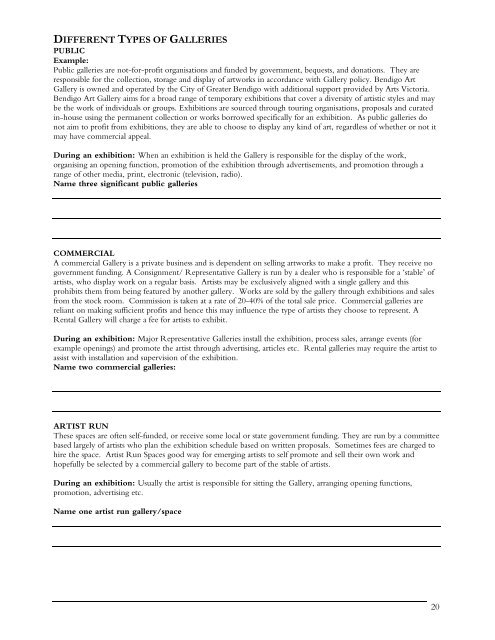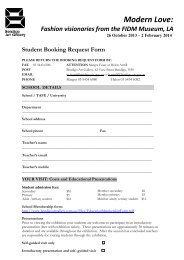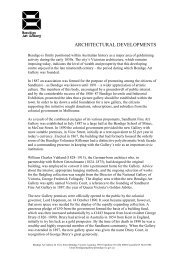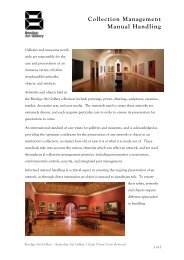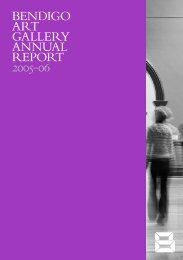Studio Arts Exam Revision booklet - Bendigo Art Gallery
Studio Arts Exam Revision booklet - Bendigo Art Gallery
Studio Arts Exam Revision booklet - Bendigo Art Gallery
Create successful ePaper yourself
Turn your PDF publications into a flip-book with our unique Google optimized e-Paper software.
DIFFERENT TYPES OF GALLERIES<br />
PUBLIC<br />
<strong>Exam</strong>ple:<br />
Public galleries are not-for-profit organisations and funded by government, bequests, and donations. They are<br />
responsible for the collection, storage and display of artworks in accordance with <strong>Gallery</strong> policy. <strong>Bendigo</strong> <strong>Art</strong><br />
<strong>Gallery</strong> is owned and operated by the City of Greater <strong>Bendigo</strong> with additional support provided by <strong><strong>Art</strong>s</strong> Victoria.<br />
<strong>Bendigo</strong> <strong>Art</strong> <strong>Gallery</strong> aims for a broad range of temporary exhibitions that cover a diversity of artistic styles and may<br />
be the work of individuals or groups. Exhibitions are sourced through touring organisations, proposals and curated<br />
in-house using the permanent collection or works borrowed specifically for an exhibition. As public galleries do<br />
not aim to profit from exhibitions, they are able to choose to display any kind of art, regardless of whether or not it<br />
may have commercial appeal.<br />
During an exhibition: When an exhibition is held the <strong>Gallery</strong> is responsible for the display of the work,<br />
organising an opening function, promotion of the exhibition through advertisements, and promotion through a<br />
range of other media, print, electronic (television, radio).<br />
Name three significant public galleries<br />
COMMERCIAL<br />
A commercial <strong>Gallery</strong> is a private business and is dependent on selling artworks to make a profit. They receive no<br />
government funding. A Consignment/ Representative <strong>Gallery</strong> is run by a dealer who is responsible for a ‘stable’ of<br />
artists, who display work on a regular basis. <strong>Art</strong>ists may be exclusively aligned with a single gallery and this<br />
prohibits them from being featured by another gallery. Works are sold by the gallery through exhibitions and sales<br />
from the stock room. Commission is taken at a rate of 20-40% of the total sale price. Commercial galleries are<br />
reliant on making sufficient profits and hence this may influence the type of artists they choose to represent. A<br />
Rental <strong>Gallery</strong> will charge a fee for artists to exhibit.<br />
During an exhibition: Major Representative Galleries install the exhibition, process sales, arrange events (for<br />
example openings) and promote the artist through advertising, articles etc. Rental galleries may require the artist to<br />
assist with installation and supervision of the exhibition.<br />
Name two commercial galleries:<br />
ARTIST RUN<br />
These spaces are often self-funded, or receive some local or state government funding. They are run by a committee<br />
based largely of artists who plan the exhibition schedule based on written proposals. Sometimes fees are charged to<br />
hire the space. <strong>Art</strong>ist Run Spaces good way for emerging artists to self promote and sell their own work and<br />
hopefully be selected by a commercial gallery to become part of the stable of artists.<br />
During an exhibition: Usually the artist is responsible for sitting the <strong>Gallery</strong>, arranging opening functions,<br />
promotion, advertising etc.<br />
Name one artist run gallery/space<br />
20


